![]()
![]()
![]()
Use LEFT and RIGHT arrow keys to navigate between flashcards;
Use UP and DOWN arrow keys to flip the card;
H to show hint;
A reads text to speech;
42 Cards in this Set
- Front
- Back
|
Selective permeability |
Allows some substances to cross it more easily than others using transport proteins Crucial to life
|
|
|
Amphiphatic |
Having both hydrophilic and hydrophobic regions
|
|
|
Fluid mosaic model |
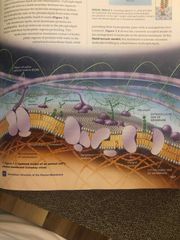
The current accepted model of the arrangements of molecules in the plasma membrane Continually being refined as new research is revealed |
|
|
Fluidity of membranes |
Fluidity of membrane is needed for its permeability and its ability to move where their function is needed Not locked rigidly in place Held together by hydrophobic interactions which are weaker than covalent bonds Movement occurs including proteins although most are held by cytoskeleton or ECM |
|
|
Temp on membranes |
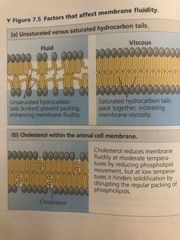
As temp decreases: settle in closely packed arrangement (like grease cooling) Unsaturated (kinks) vs saturated Steroid: cholesterol has different effects membrane fluidity at different temps “Fluidity buffer” |
|
|
Evolution of membranes |
Adjusting to temps so membranes remain fluid is key to survival |
|
|
2 major populations of membrane proteins |
Integral Peripheral |
|
|
Integral proteins |
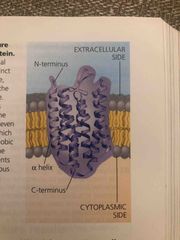
Go through the hydrophobic lipid bilayer Majority are transmembrane proteins The hydrophobic regions consist of nonpolar amino acids, coiled, alpha helix Hydrophilic parts are exposed to aqueous solutions on either side of membrane |
|
|
Integral proteins |
Go through the hydrophobic lipid bilayer Majority are transmembrane proteins The hydrophobic regions consist of nonpolar amino acids, coiled, alpha helix Hydrophilic parts are exposed to aqueous solutions on either side of membrane |
|
|
Proteins of the plasma membrane (mosaic) |

Back (Definition) |
|
|
Importance of genes and cells and HIV virus |
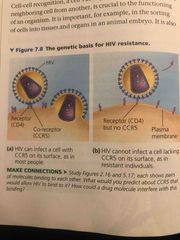
Back (Definition) |
|
|
Cell-cell recognition and membranes |
Cells need to recognize other cells (sorting out tissues and organs or rejecting foreign cells) Cells do this by binding onto molecules, often containing carbs, on the surface of membranes Glycolipids and glycoproteins (secreted from rough ER) |
|
|
Cell-cell recognition and membranes |
Cells need to recognize other cells (sorting out tissues and organs or rejecting foreign cells) Cells do this by binding onto molecules, often containing carbs, on the surface of membranes Glycolipids and glycoproteins |
|
|
Glycolipids vs glycoproteins |
Molecules formed by covalent bonds of short branched chains of carbs to membrane Glycoproteins are the same except bonds to protein instead of membrane |
|
|
Due to diversity of molecules and their locations... |
Carbohydrates serve as markers for cells to distinguish one another ie: 4 human blood types reflect variation in carbs part of glycoproteins on red blood cells |
|
|
Transport proteins |
Allow hydrophilic, polar molecules to cross membrane Channel proteins=some transport proteins that provide a tunnel (hydrophilic tunnel) Carrier proteins=bind to molecule, changing the shape, and help to cross |
|
|
Transport proteins |
Allow hydrophilic, polar molecules to cross membrane Channel proteins=some transport proteins that provide a tunnel Carrier proteins=bind to molecule, changing the shape, and help to cross |
|
|
Diffusion of a substance across a membrane with no energy investment.. |
Passive transport |
|
|
Diffusion |
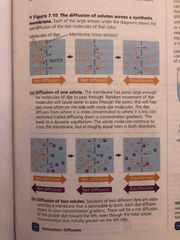
Movement of particles (thermal energy) of any substance so that they spread out into the available space Spontaneous process |
|
|
Concentration gradient |
A substance will diffuse from where it is more concentrated to where it is less concentrated Each substance has its own concentration gradient ie: cell respiration-oxygen diffuses, oxygen is consumed and because gradient favors movement Represent potential energy and drives diffusion |
|
|
Passive transport |
Act of diffusion is passive bc cell does not have to expend energy to make it happen |
|
|
Osmosis |
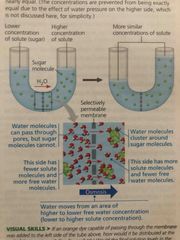
Diffusion of free water Diffuses from the less concentrate to the more concentrate to bind with the molecules (solutes) |
|
|
Tonicity |
Ability of a surrounding solution to cause a cell to gain or lose water |
|
|
Isotonic |
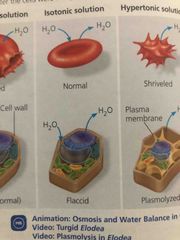
ISO=same In animal cell: remains same. Water diffuses at same rate Think about osmosis |
|
|
Hypertonic |

Hyper=more Cell will lose water, shrivel, and die ie: high salt solution in water can kill the animals that live there Think about osmosis |
|
|
Hypotonic |
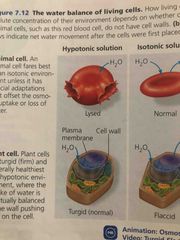
Hypo=less Water will enter cell faster than it leaves causing cell to swell and burst Water moved based on osmosis |
|
|
Osmoregulation |
Control of solute concentrations and water balance Some cells have vacuoles that help pump water out and maintain blanace |
|
|
Water balance in cell walls |
Cell walls help maintain balance Includes turgid and flaccid |
|
|
Turgid and flaccid |
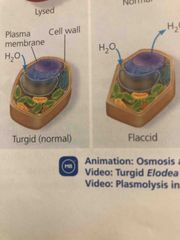
Firm, healthy state for most plants Plants wilt due to isotonic |
|
|
Plasmolysis |
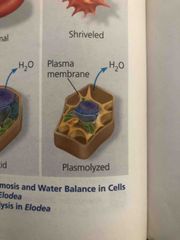
Due to hypertonic Plant cell shrivels, it’s plasma membrane pulls away from cell wall Leads to cell death Also occurs in bacteria and fungi |
|
|
Facilitated diffusion |
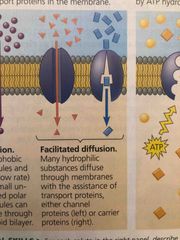
Polar molecules (impeded by lipid bilayer due to its hydrophobic tails) being assured by transport proteins to diffuse passively |
|
|
Ion channels |
Channel proteins that transport ions Function as gated channels |
|
|
Gated channels |
Ion channels that Open or close in response to a stimulus Some, the stimulus is electrical Some in response to a substance ie: in neuron, an ion channel opens in response to an electrical stimulus allowing a steam of potassium ions to exit the cell |
|
|
Active transport |
To pump a solute across a membrane against its gradient requires work Carrier proteins Allows a cell to maintain internal concentrations ATP hydrolysis supplies often the energy |
|
|
Sodium-potassium pump |
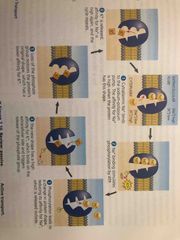
Exchanges NA for K across membrane Occurs when Na concentration is high outside the cell and low inside while K low outside the cell and high inside |
|
|
Membrane potential |
Voltage across a membrane (ranges from -50 to -200 milivolts) Voltage is electrical potential energy (separation of opposite charges) Cytoplasmic side is negative in charge (so membrane favors cations into the cell and anions out) |
|
|
Electrochemical gradient |
2 forced drive the diffusion of ions Chemical force(ions gradient) and an electrical force (membrane potential) ie: resting nerve cell-concentrations of Na are lower inside. Cell is stimulated, gated channels open for diffusion of Na |
|
|
Electrogenic pump |
A transport protein that generates voltage Sodium potassium pump pumps out 3 Na for every 2 K leaving a net charge of +1. |
|
|
Cotransport proteins |
A single ATP powered pump to drive the active transport of different solutes One goes with its concentration gradient and the other against it |
|
|
In receptor-mediated endocytosis, only a specific molecule can bind to a receptor. What is it? |
Ligand Without receptor binding occurring first, endocytosis cannot proceed |
|
|
In Exocytosis, vesicles form the endomembrane system fuse with plasma membrane and do what? |
Increase number of phospholipids, thus increasing its surface area The smooth ER is responsible for lipid production |
|
|
A way in which cells can move large molecules across the plasma membrane |
Endocytosis |

